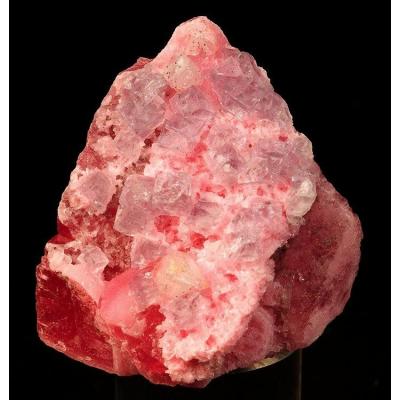
Posted in: All Things Jewelry
 This gorgeous combination rhodochrosite-fluorite specimen emerged from the Wutong Mine in China in 2009. The cherry red rhodochrosite comprises the majority of the specimen, with a smattering of pale lavender cubes of fluorite layered across its surface. Photo by Robert M. Lavinsky, CC-BY-SA-3.0.
Rhodochrosite in its purest form possesses a rich raspberry or cherry red color. Most often it presents as accumulated layers on the walls or floors of caves. It also forms in stalactites and stalagmites. This unique and beautiful gemstone belongs to a large mineral category called carbonates.
This gorgeous combination rhodochrosite-fluorite specimen emerged from the Wutong Mine in China in 2009. The cherry red rhodochrosite comprises the majority of the specimen, with a smattering of pale lavender cubes of fluorite layered across its surface. Photo by Robert M. Lavinsky, CC-BY-SA-3.0.
Rhodochrosite in its purest form possesses a rich raspberry or cherry red color. Most often it presents as accumulated layers on the walls or floors of caves. It also forms in stalactites and stalagmites. This unique and beautiful gemstone belongs to a large mineral category called carbonates.
Calcite Carbonates
According to Minerals.net, carbonates contain one or more metallic elements in addition to a carbonate radical (CO3). Primarily lightly colored and transparent, this mineral group further expands into two groups of minerals - the calcite group and the argonite group. As I have noted, rhodochrosite belongs to the calcite group. All calcite carbonates share an identical molecular arrangement where the each primary element proves interchangeable with other elements. The minerals that belong to this group sometimes fully or partially replace each other in the structure, transforming one species into another. Mineralogists refer to this quality as isomorphous. (source) In the case of rhodochrosite, the primary element is manganese which gives the stone its red hues.Rhodochrosite Color
Of course, the most coveted colors of this gorgeous gemstone include raspberry and cherry red. It also comes in various shades of pink, sometimes with a slightly orange tint. As a result of the gem's isomorphic properties, sometimes calcium, zinc, iron, and/or magnesium replace some of the manganese. In this situation, lighter shades of pink result. Once in a while, these substitutions result in hues of yellow, pale brown, white, and yellow-grey.Rhodochrosite Formation
This gorgeous gemstone begins as a hydrothermal solution of manganese, ground water, and carbonate material, and occasionally other elements. This solution flows into hollow cavities, coating every surface, filling every crevice. Layer upon layer of crystalline icing forms a thick blanket of gemstone. Near the surface of these slabs, free-form rhodochrosite develops as rhombohedral or scalenohedral crystals. As a member of the calcite carbonate group, this beautiful gem exhibits double refraction and forms in clusters of crystals. (source) Sometimes, through small holes and cracks in the walls of these cavities, this manganese-rich solution drips steadily down, creating stalactites and stalagmites. Since each layer results from a unique flow of hydrothermal solution, when cut away in slabs rhodochrosite demonstrates concentric pink bands. (source) Occasionally these bands form a zig-zag pattern. Most often, they form in curving, sometimes contorted ribbons. Lapidarists purchase these great pink slabs, cutting them further into cabochons or sculpting them into figurines or pendants. We recently sold our rhodochrosite crystal ring. However, one of my favorite gemstones also belongs to the calcium carbonate family. Check out this unique malachite arch ring! ~Angela Magnotti Andrews5 years ago
4 view(s) 